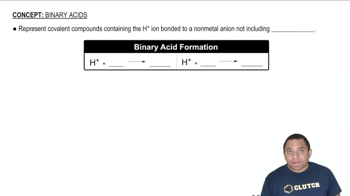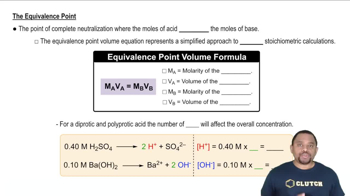Two buffers are prepared by adding an equal number of moles of formic acid (HCOOH) and sodium formate (HCOONa) to enough water to make 1.00 L of solution. Buffer A is prepared using 1.00 mol each of formic acid and sodium formate. Buffer B is prepared by using 0.010 mol of each. (b) Which buffer will have the greater buffer capacity?
Ch.17 - Additional Aspects of Aqueous Equilibria
Chapter 17, Problem 90a
A sample of 0.2140 g of an unknown monoprotic acid was dissolved in 25.0 mL of water and titrated with 0.0950 M NaOH. The acid required 30.0 mL of base to reach the equivalence point. (a) What is the molar mass of the acid?
 Verified step by step guidance
Verified step by step guidance1
Step 1: Calculate the moles of NaOH used in the titration. The molarity of a solution is defined as the moles of solute per liter of solution. Therefore, to find the moles of NaOH, multiply the volume of the NaOH solution (in liters) by its molarity.
Step 2: Since the unknown acid is monoprotic, it means that one mole of the acid reacts with one mole of NaOH. Therefore, the moles of the unknown acid are equal to the moles of NaOH calculated in step 1.
Step 3: The molar mass of a substance is defined as the mass of the substance divided by the number of moles. Therefore, to find the molar mass of the unknown acid, divide the mass of the acid (in grams) by the moles of the acid calculated in step 2.
Step 4: The result from step 3 will give you the molar mass of the unknown acid in grams per mole (g/mol).
Step 5: Check your answer to make sure it makes sense. The molar mass should be a positive number, and it should be within a reasonable range for a monoprotic acid.

Verified video answer for a similar problem:
This video solution was recommended by our tutors as helpful for the problem above.
Video duration:
3mWas this helpful?
Key Concepts
Here are the essential concepts you must grasp in order to answer the question correctly.
Monoprotic Acid
A monoprotic acid is an acid that can donate only one proton (H+) per molecule during a chemical reaction. This characteristic simplifies titration calculations, as the amount of base required to neutralize the acid directly correlates to the number of moles of the acid present in the solution.
Recommended video:
Guided course

Binary Acids
Titration and Equivalence Point
Titration is a quantitative analytical method used to determine the concentration of a solute in a solution. The equivalence point is reached when the amount of titrant added is stoichiometrically equivalent to the amount of substance being titrated, indicating that the reaction is complete. This point is crucial for calculating the molar mass of the unknown acid.
Recommended video:
Guided course

Equivalence Point in Titration
Molar Mass Calculation
Molar mass is the mass of one mole of a substance, typically expressed in grams per mole (g/mol). To calculate the molar mass of the unknown acid, one must first determine the number of moles of acid neutralized by the titrant using the volume and concentration of the NaOH solution, and then relate this to the mass of the acid sample.
Recommended video:
Guided course

Molar Mass Calculation Example
Related Practice
Textbook Question
Textbook Question
A sample of 0.1687 g of an unknown monoprotic acid was dissolved in 25.0 mL of water and titrated with 0.1150 M NaOH. The acid required 15.5 mL of base to reach the equivalence point. (a) What is the molar mass of the acid?
Textbook Question
A sample of 0.1687 g of an unknown monoprotic acid was dissolved in 25.0 mL of water and titrated with 0.1150 M NaOH. The acid required 15.5 mL of base to reach the equivalence point. (b) After 7.25 mL of base had been added in the titration, the pH was found to be 2.85. What is the Ka for the unknown acid?
Textbook Question
Mathematically prove that the pH at the halfway point of a titration of a weak acid with a strong base (where the volume of added base is half of that needed to reach the equivalence point) is equal to pKa for the acid.
